
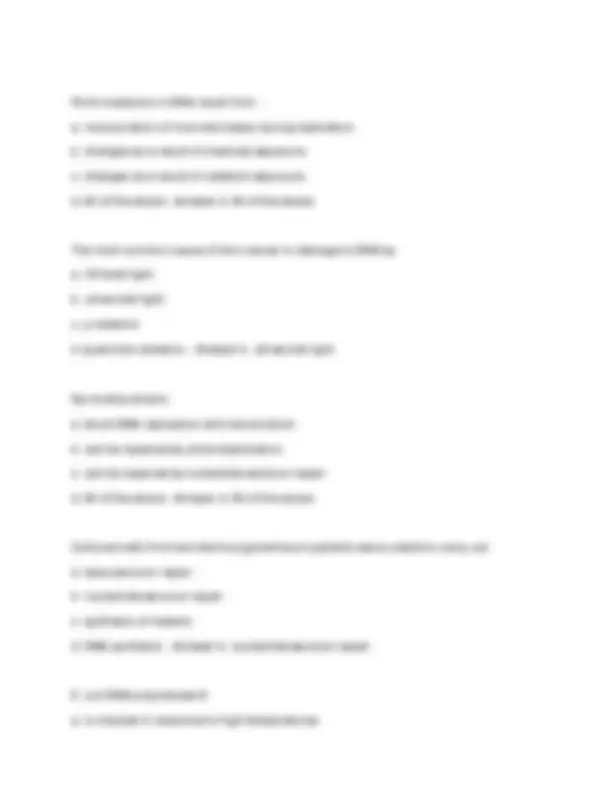
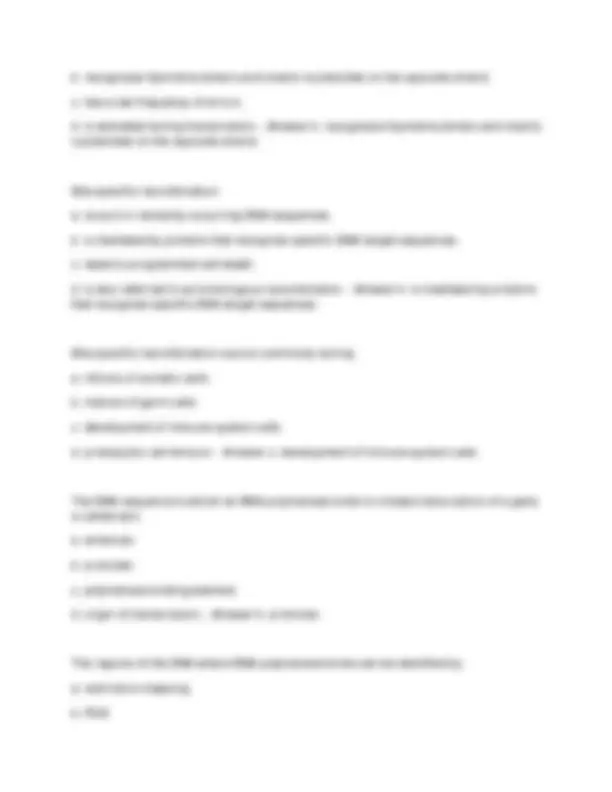
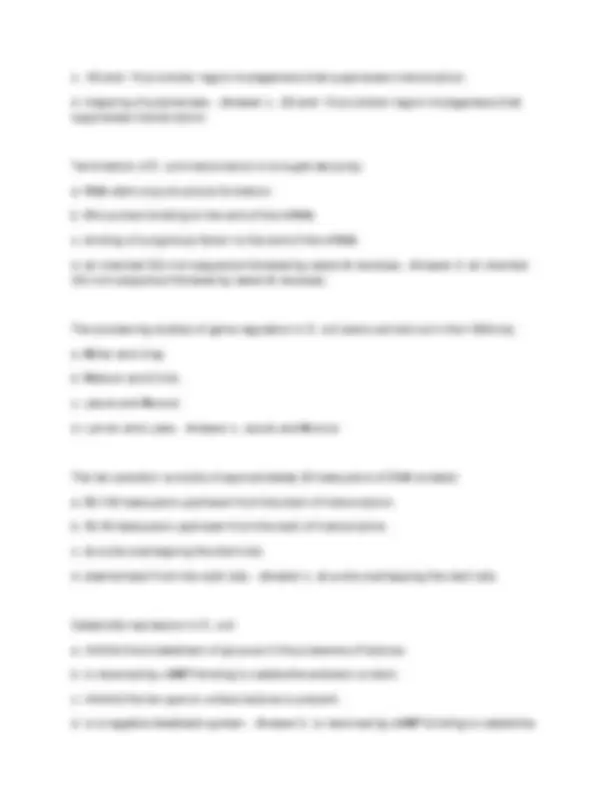
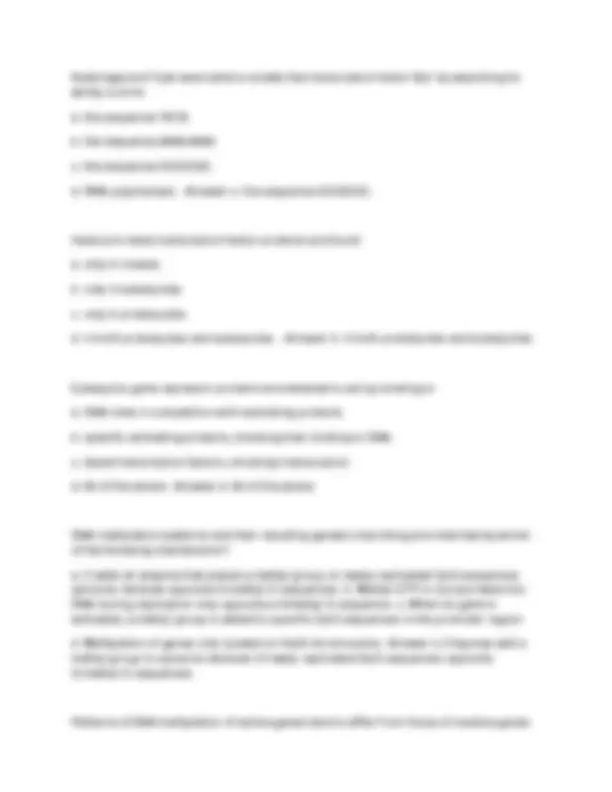
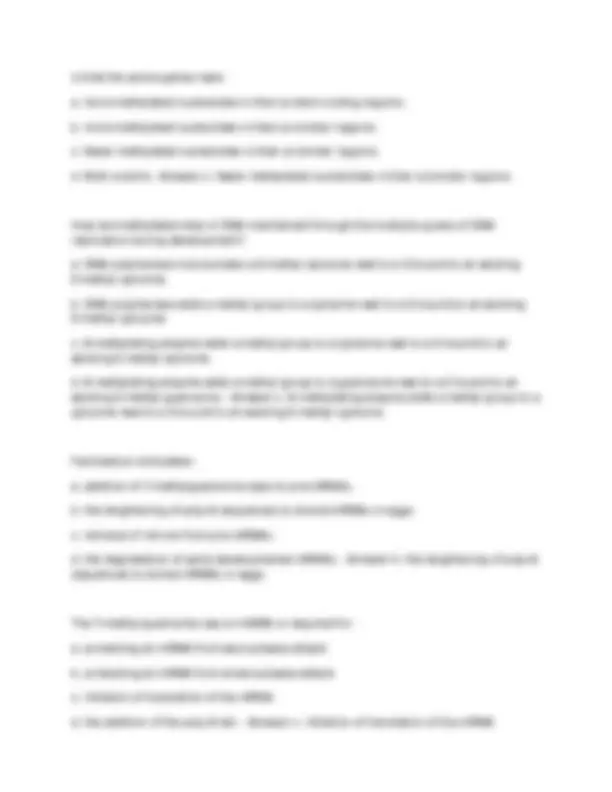
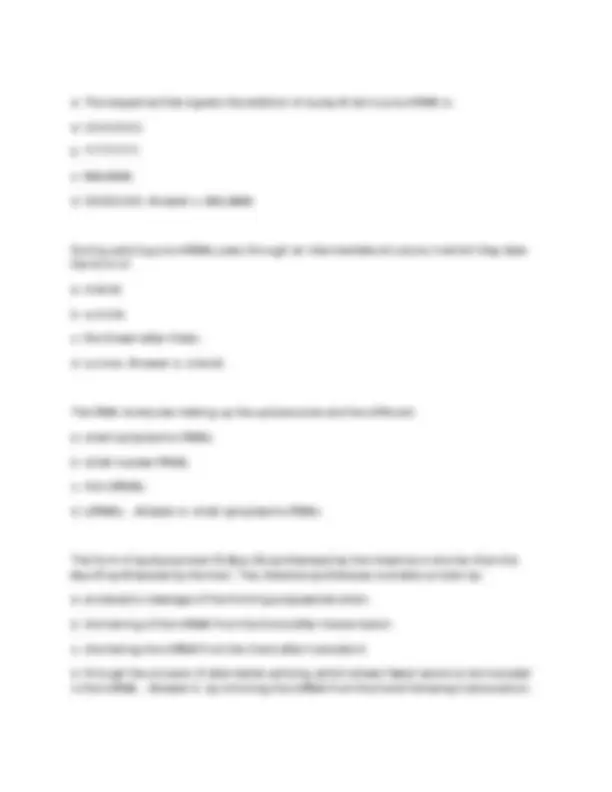
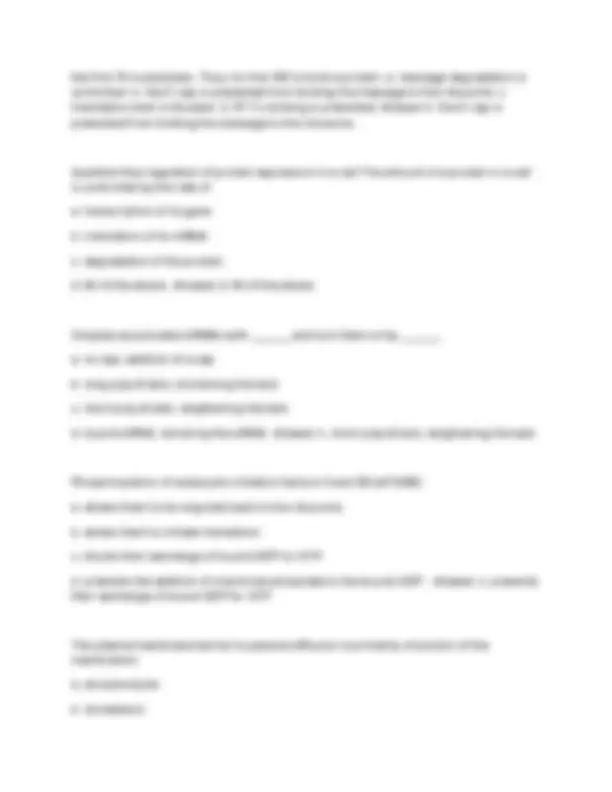
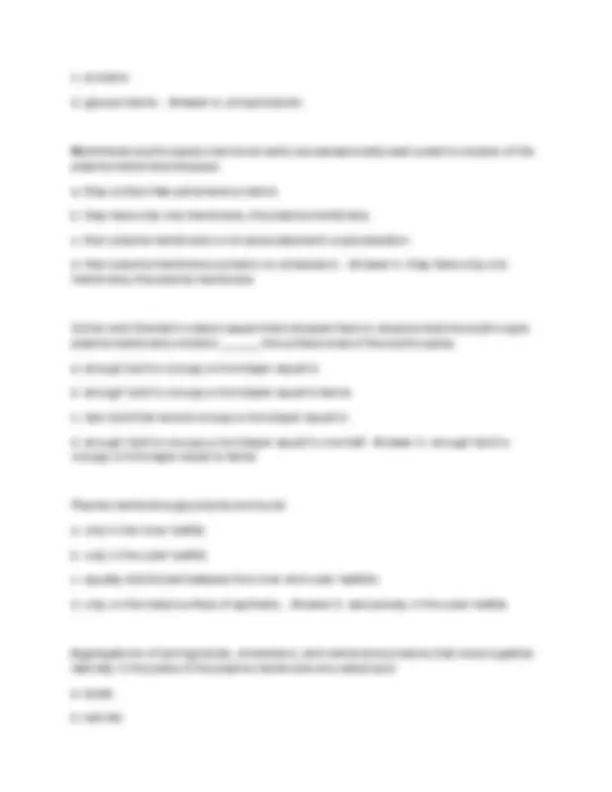
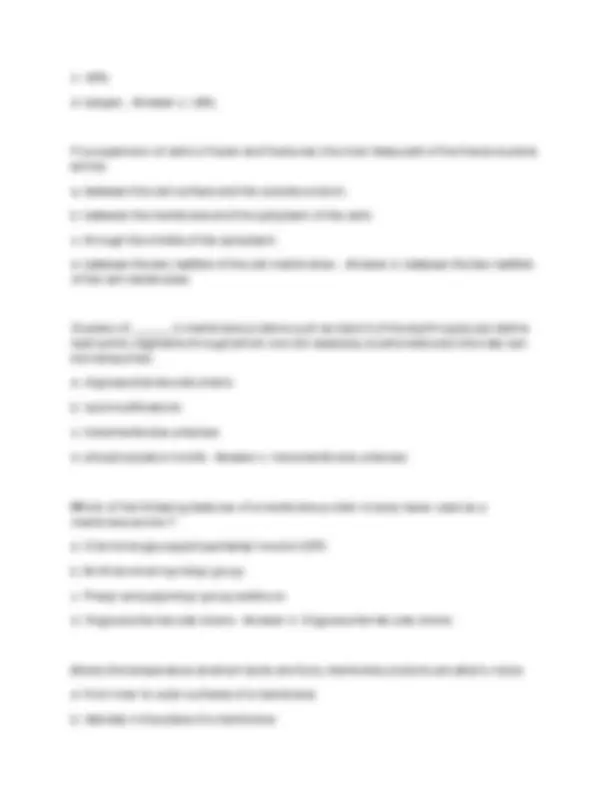
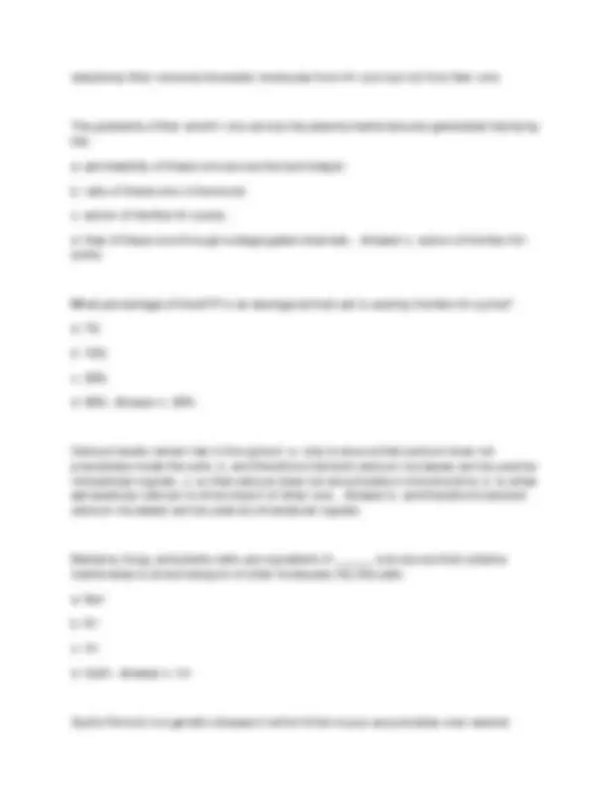
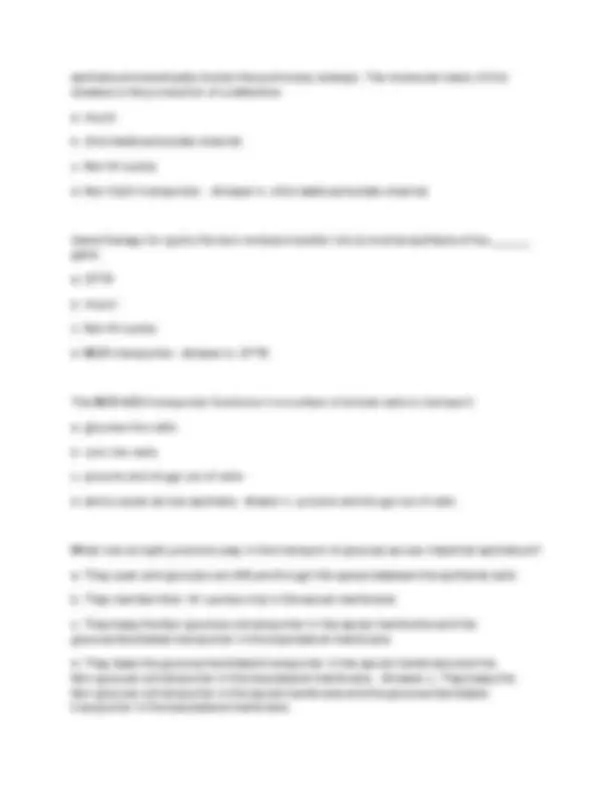
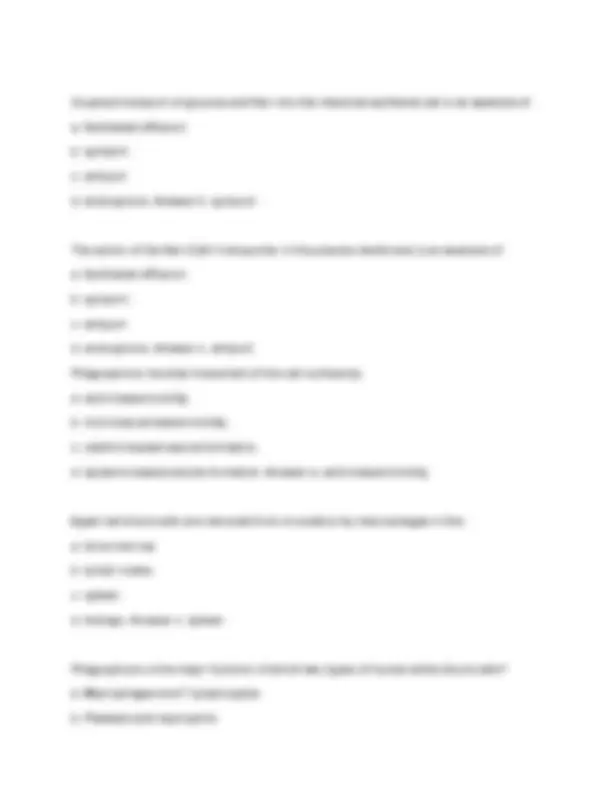
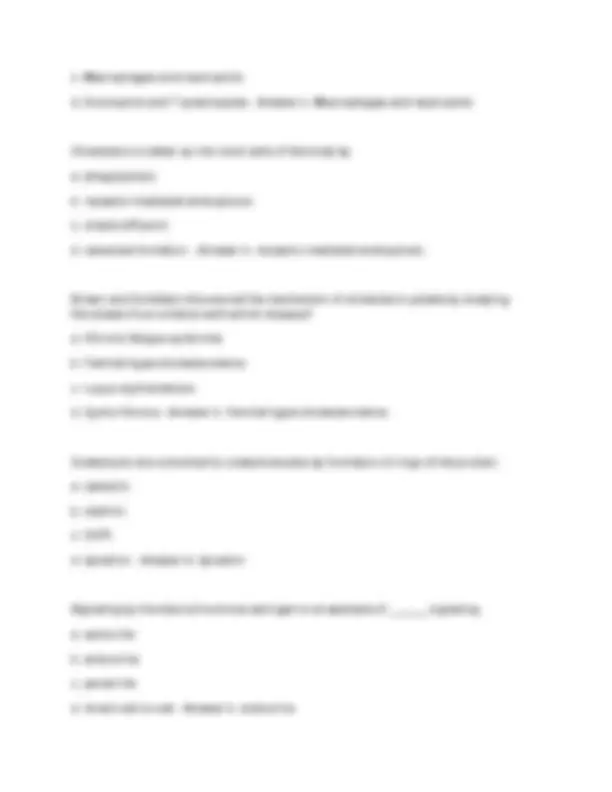
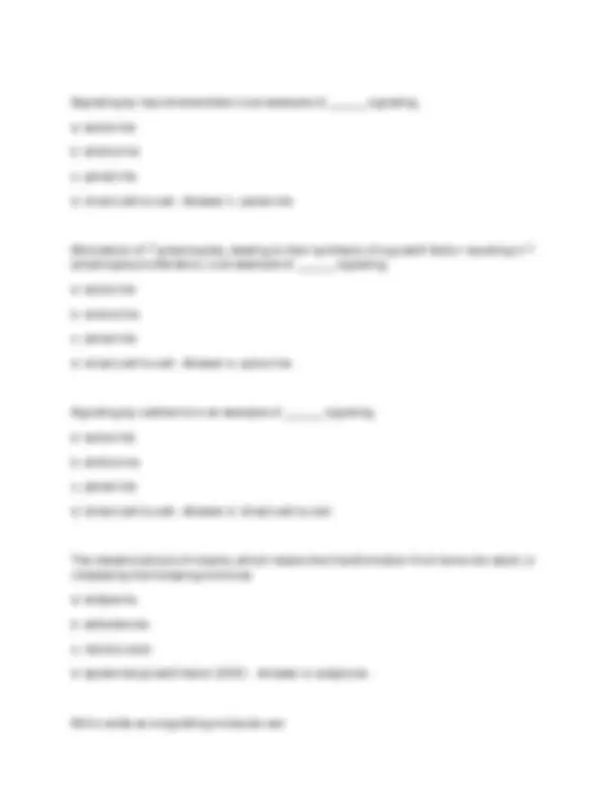
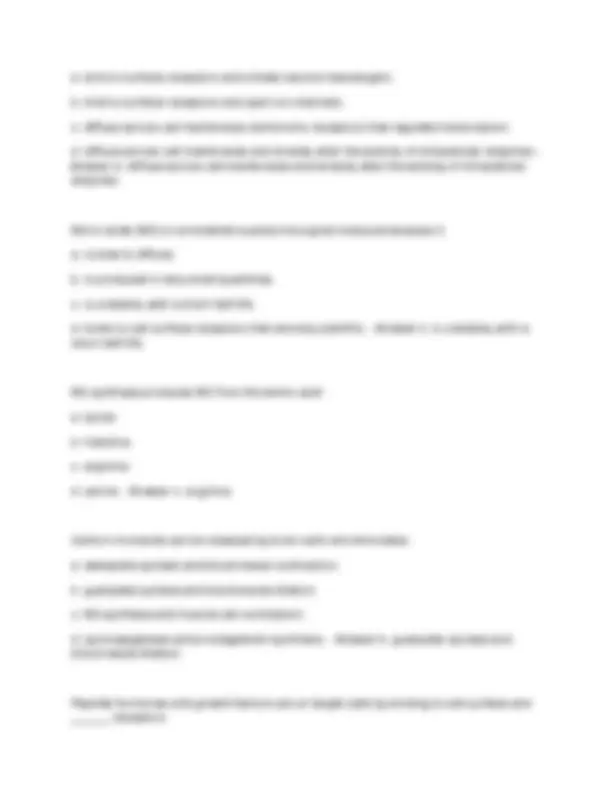

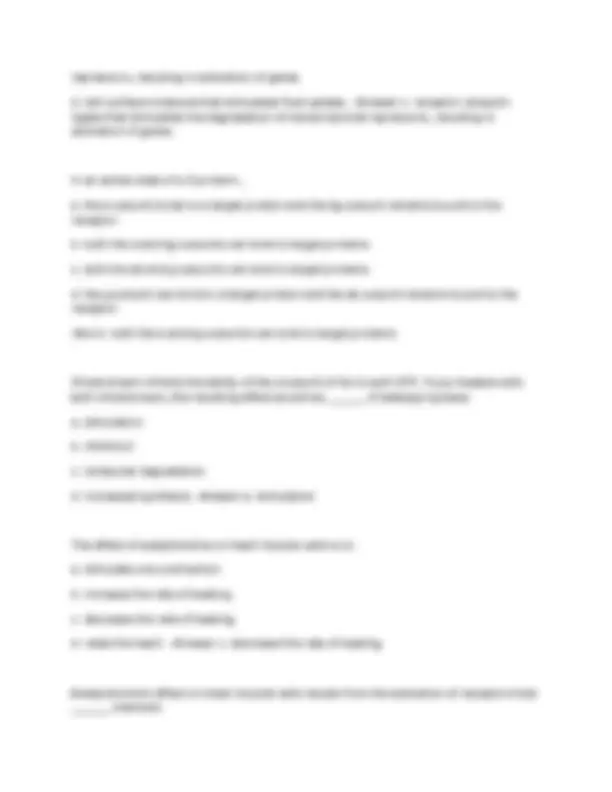
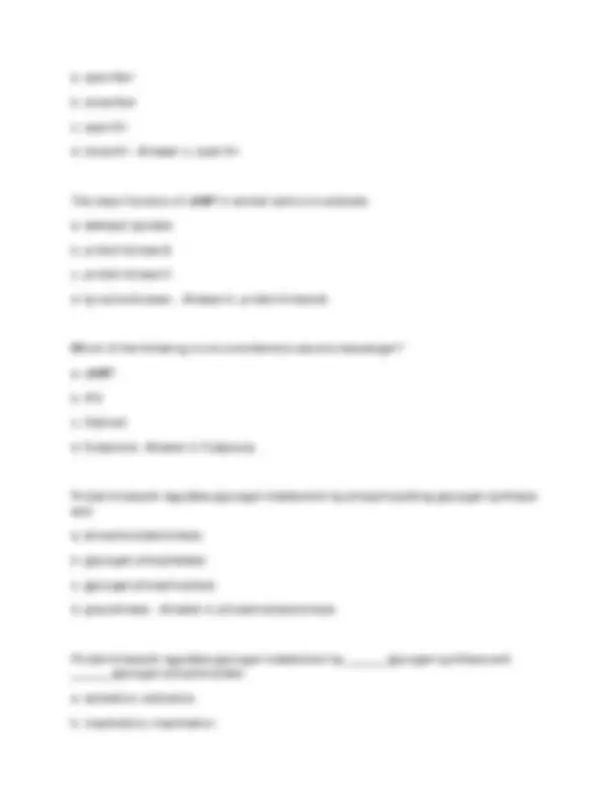
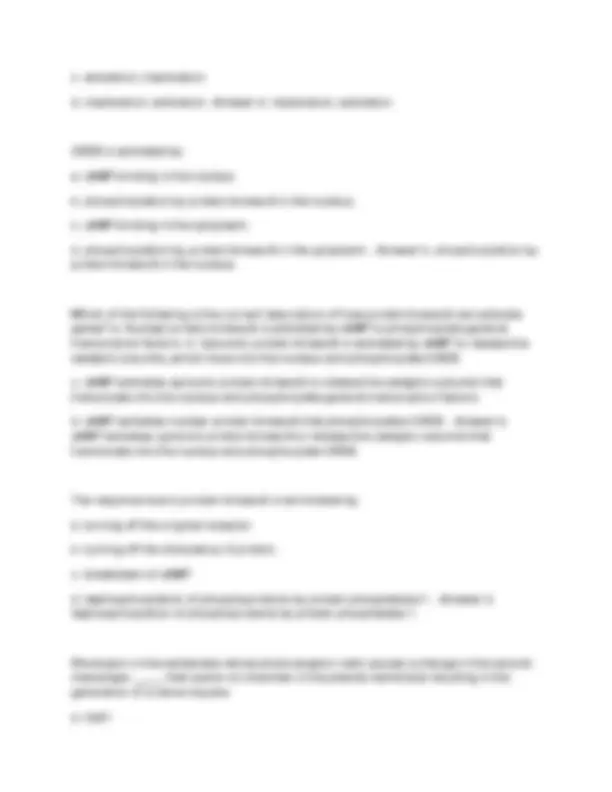
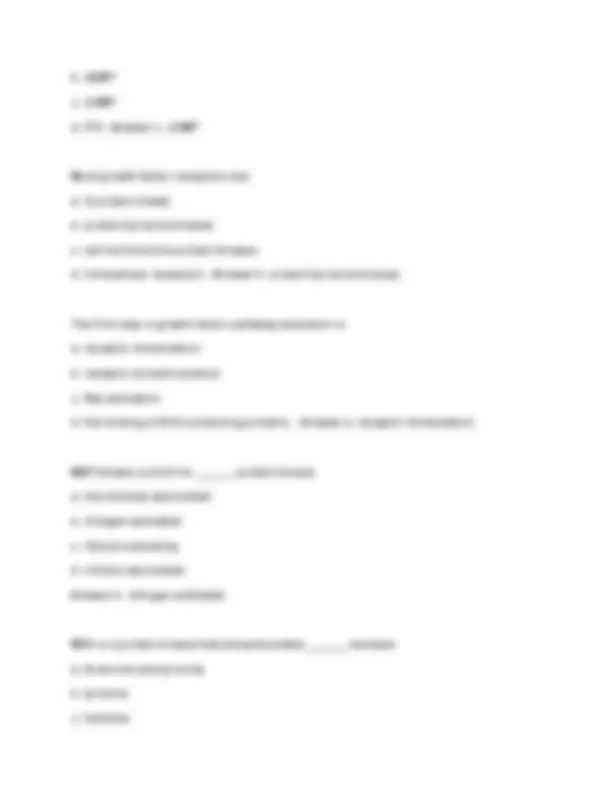
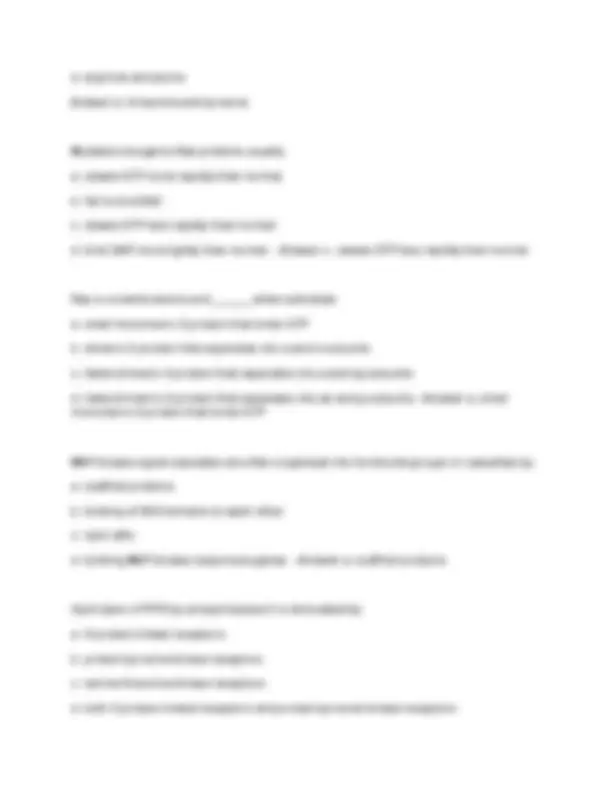
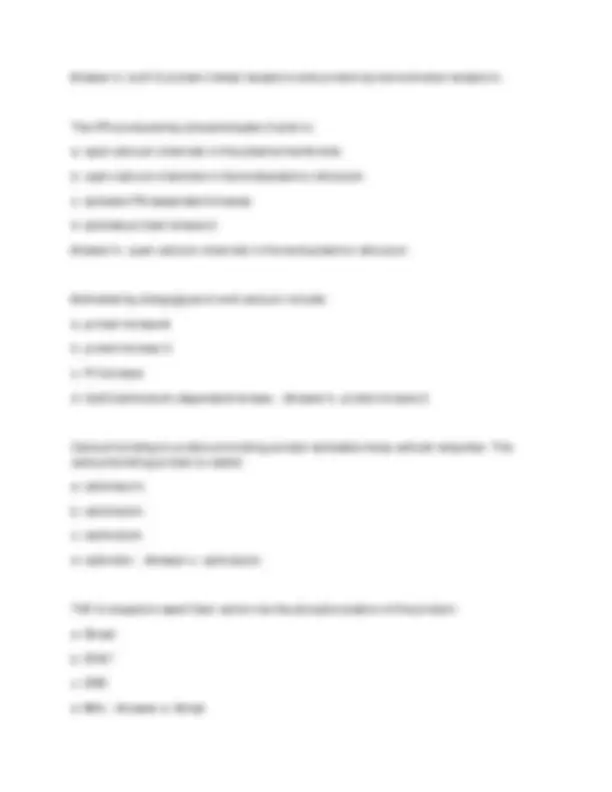
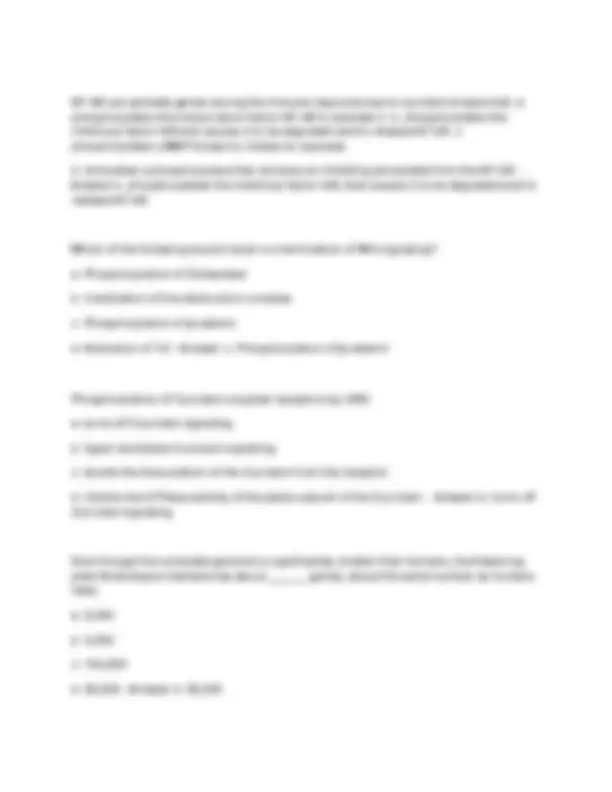
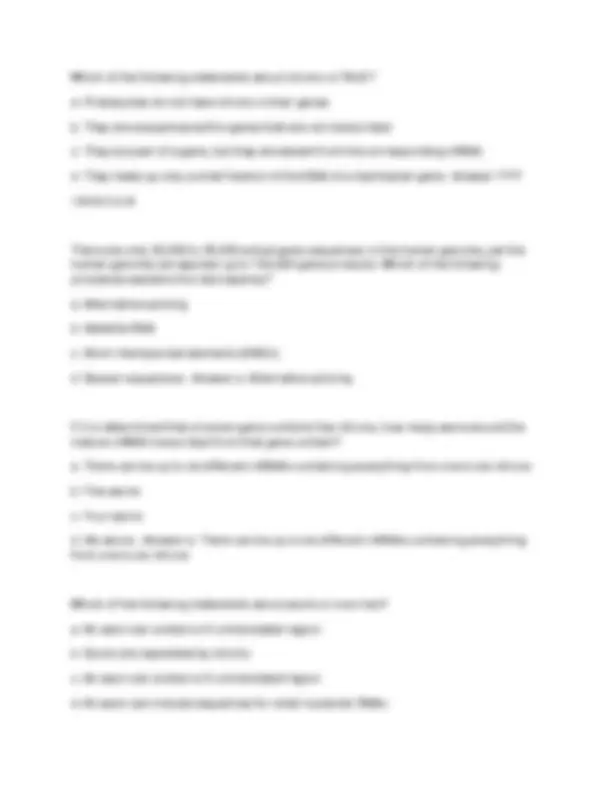
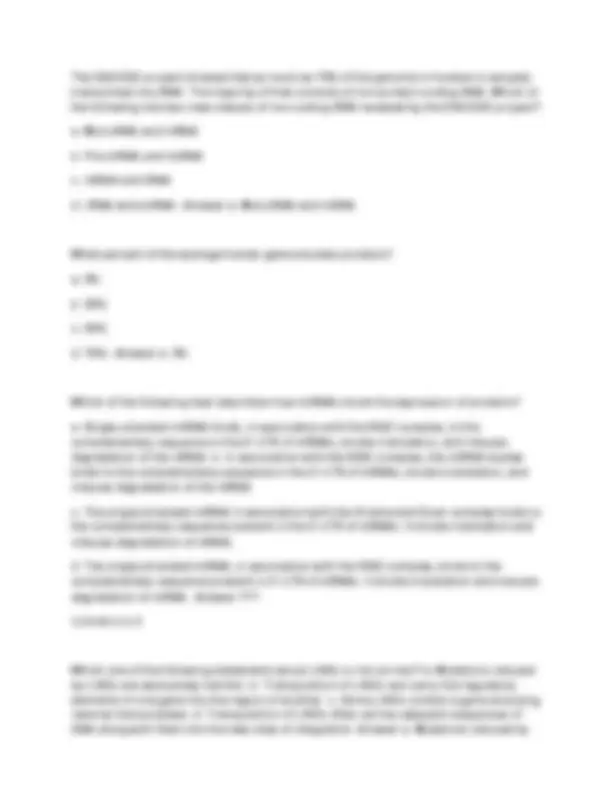
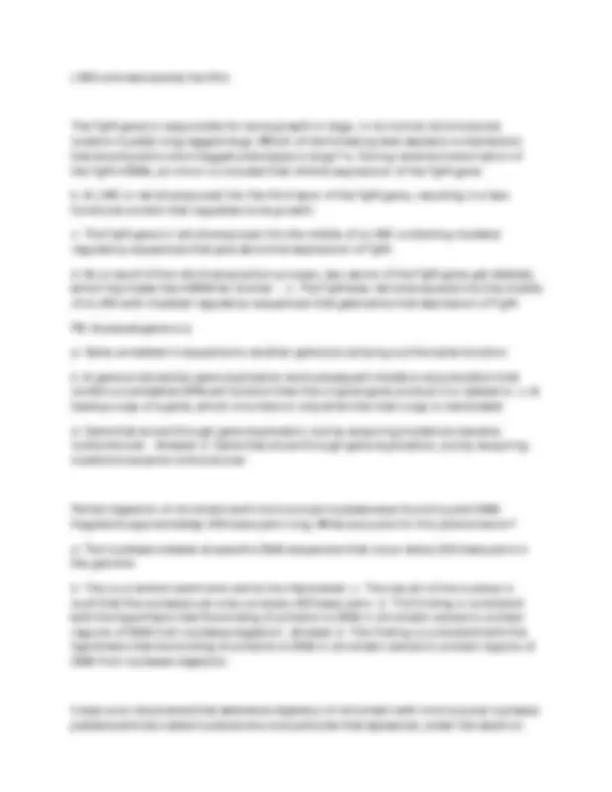
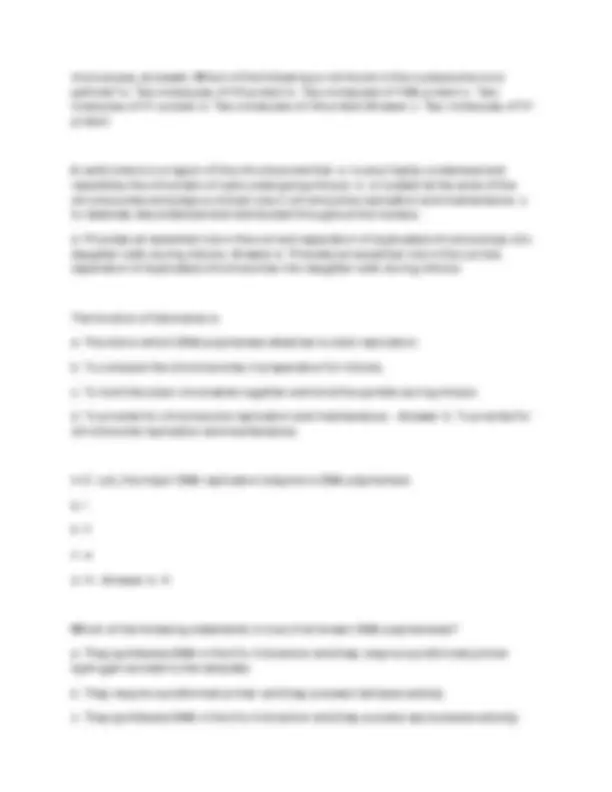
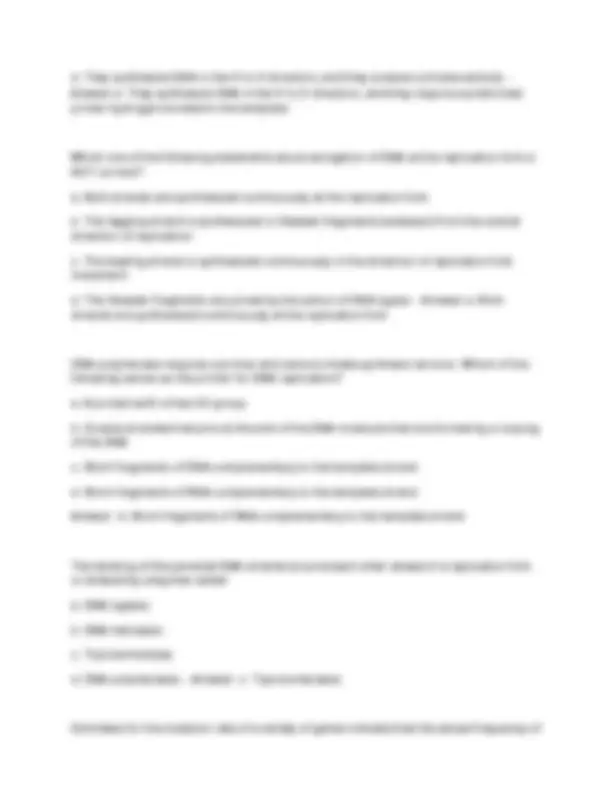
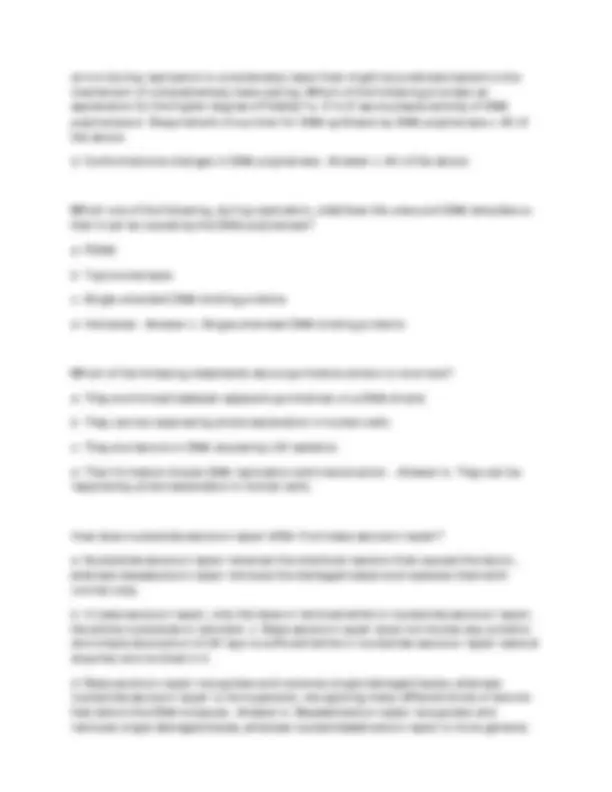
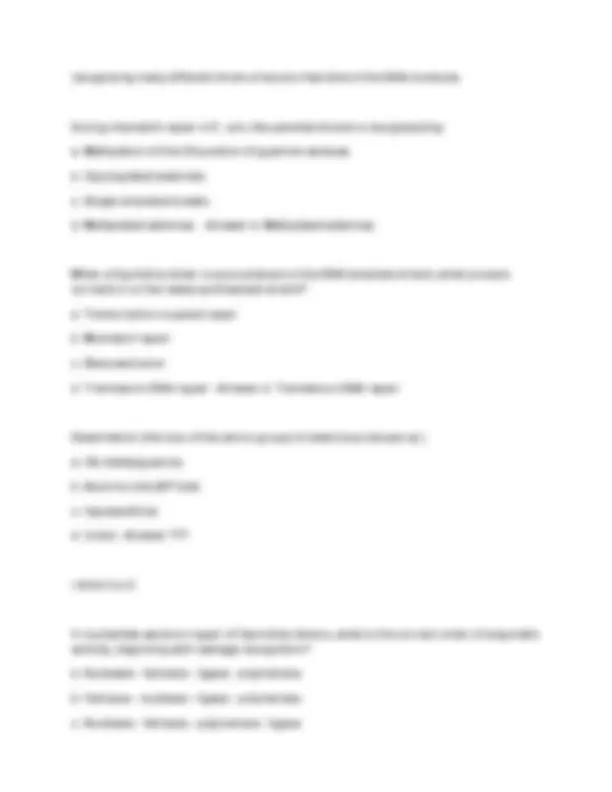
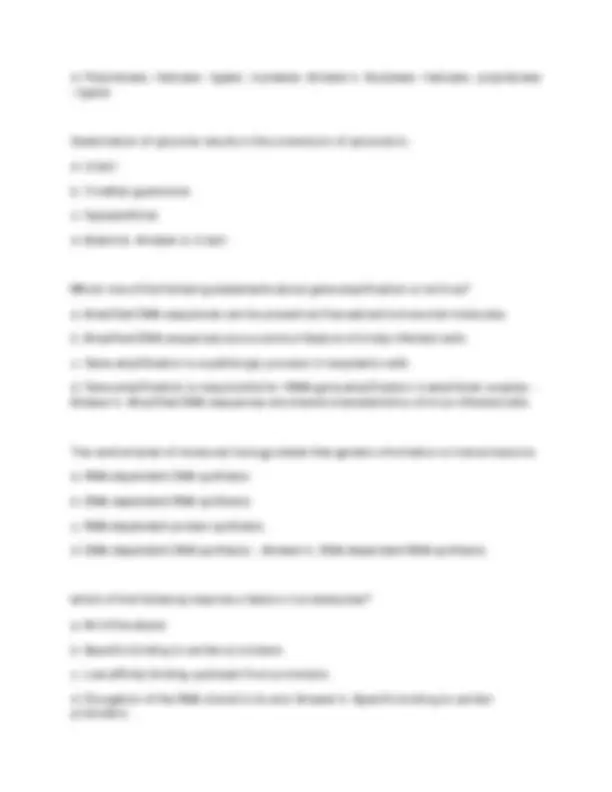
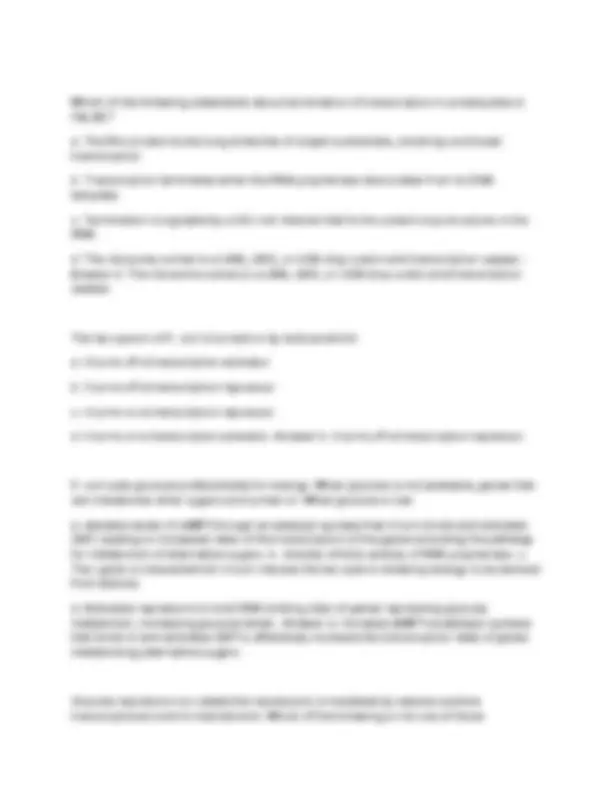
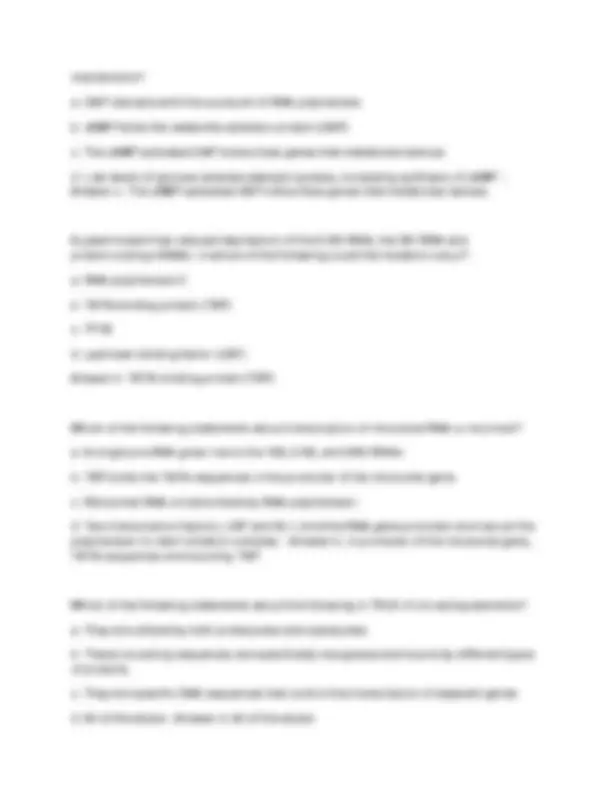
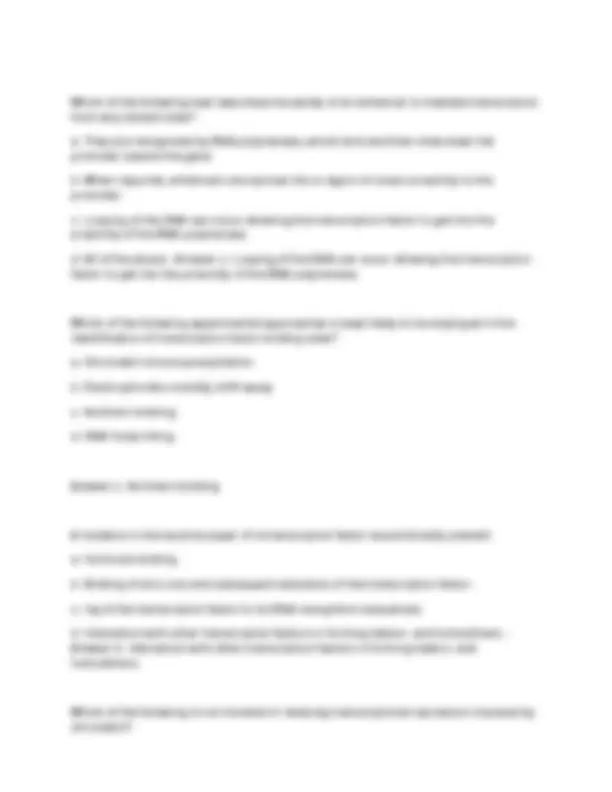
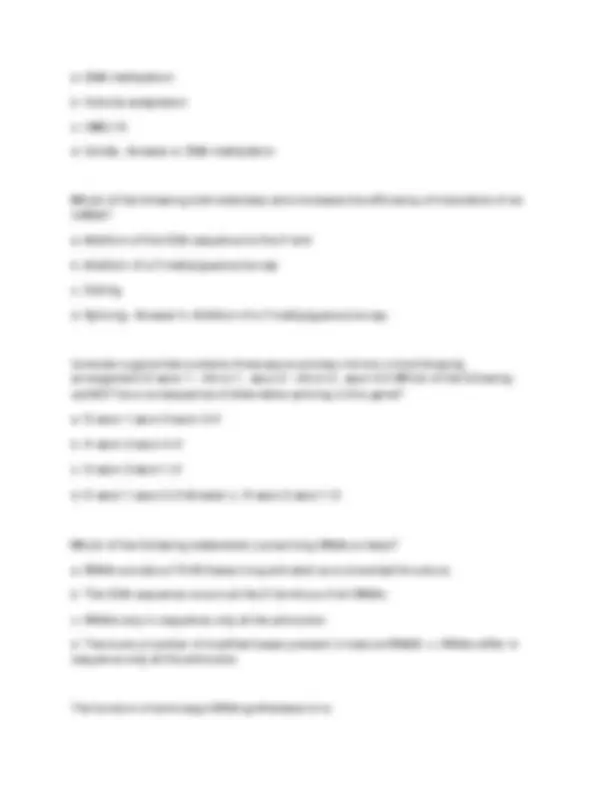
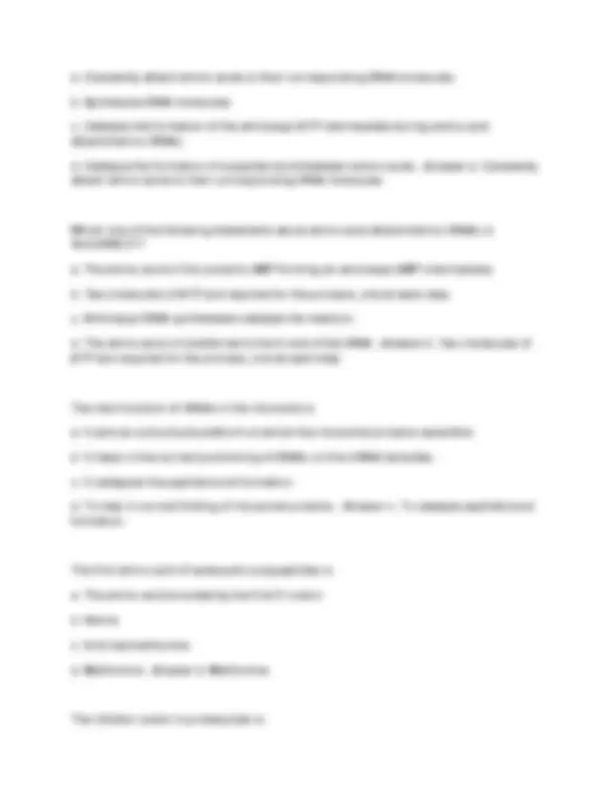
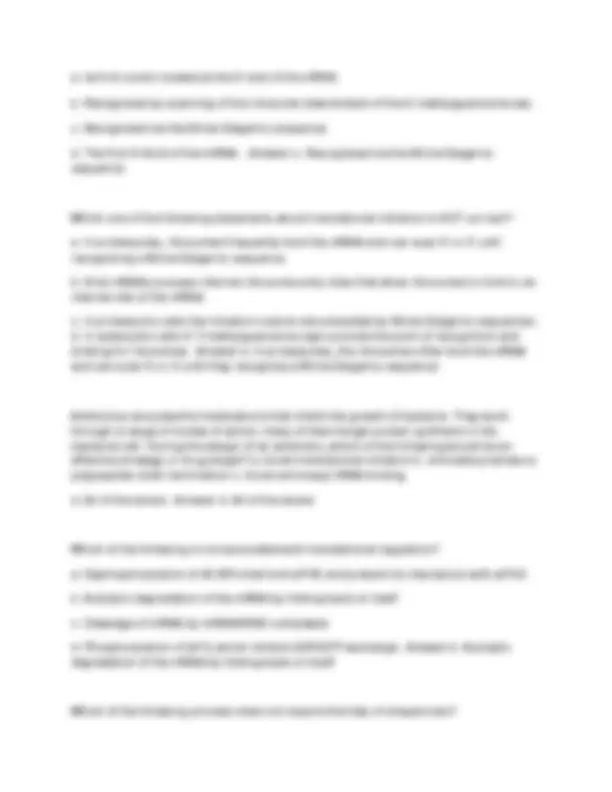
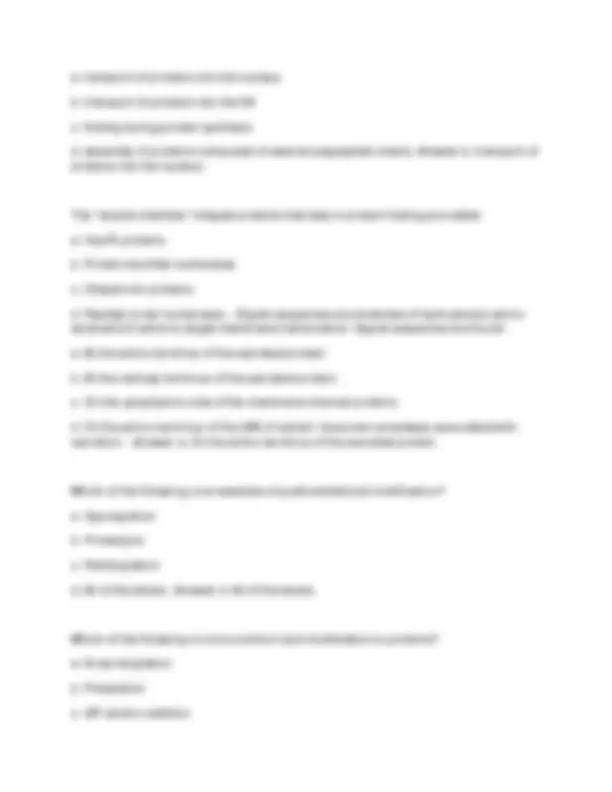
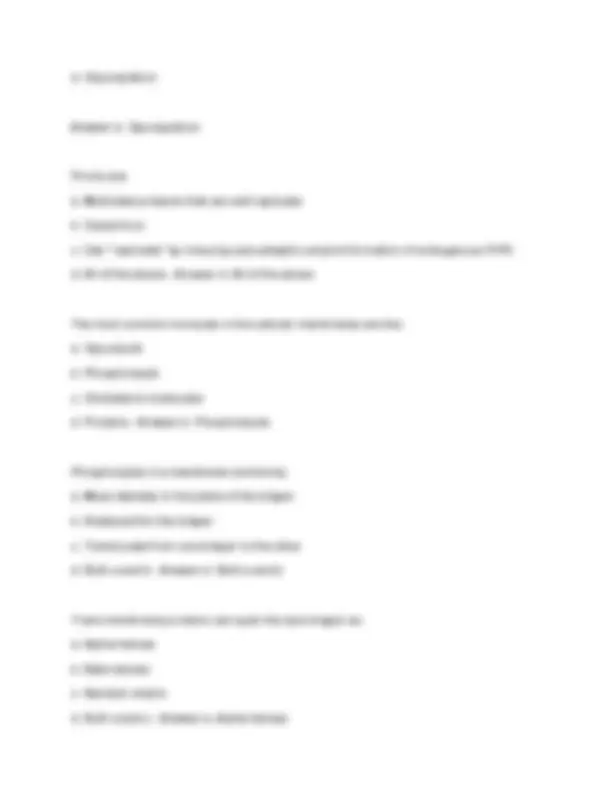
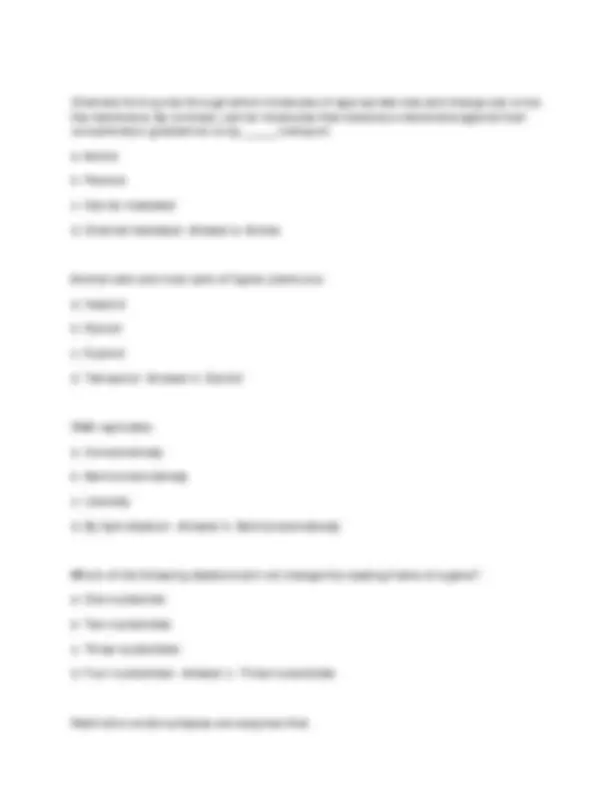
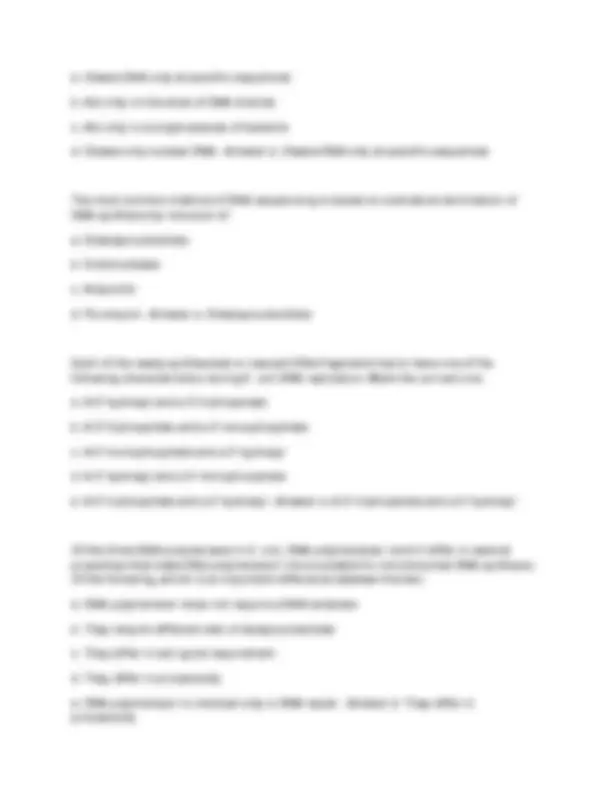
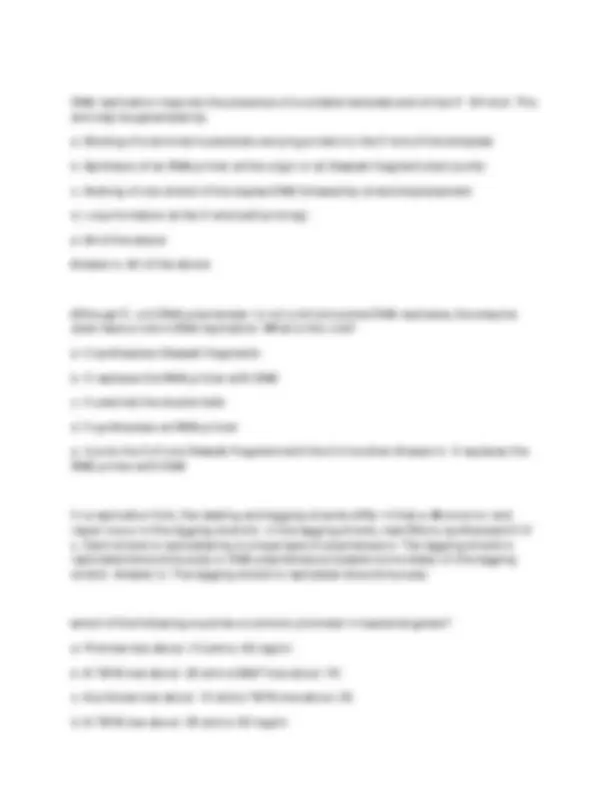
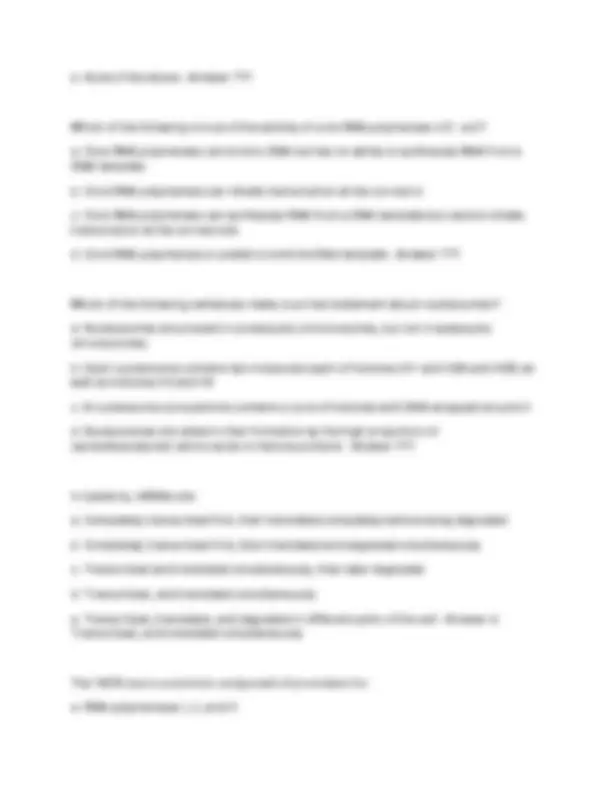
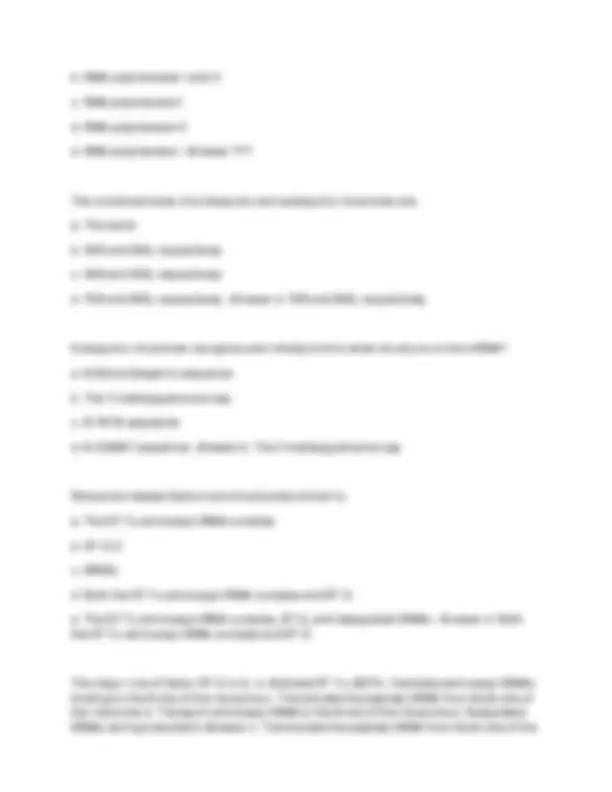



Study with the several resources on Docsity

Earn points by helping other students or get them with a premium plan


Prepare for your exams
Study with the several resources on Docsity

Earn points to download
Earn points by helping other students or get them with a premium plan
Community
Ask the community for help and clear up your study doubts
Discover the best universities in your country according to Docsity users
Free resources
Download our free guides on studying techniques, anxiety management strategies, and thesis advice from Docsity tutors
A series of multiple-choice questions and answers related to molecular biology, specifically focusing on dna replication, transcription, and related enzymatic activities. It covers topics such as the roles of different dna polymerases, the function of topoisomerases, dna repair mechanisms, and the regulation of gene expression in both prokaryotes and eukaryotes. The questions test understanding of key concepts and processes in molecular biology, making it a useful resource for students studying for exams or seeking to reinforce their knowledge. It provides direct answers to each question, facilitating quick review and self-assessment. This material is suitable for university-level courses in molecular biology, genetics, and biochemistry.
Typology: Exams
1 / 53

This page cannot be seen from the preview
Don't miss anything!














































Which eukaryotic DNA polymerase replicates the lagging strand in the 3ʹ to 5ʹ direction? a. α b. γ c. δ d. None of the above; the lagging strand is replicated in the 5ʹ to 3ʹ direction. Answer d. None of the above; the lagging strand is replicated in the 5ʹ to 3ʹ direction.
DNA polymerases can synthesize DNA: a. de novo, by catalyzing the polymerization of free dNTPs. b. to complementary dNTPs by adding on a single-stranded DNA. c. to a hydroxyl group at the end of a growing polynucleotide chain hydrogen bonded to a strand of RNA. d. by the addition of dNTPs to a hydroxyl group at the end of a growing polynucleotide chain that is hydrogen-bonded to a strand of DNA. -Answer d. by the addition of dNTPs to a hydroxyl group at the end of a growing polynucleotide chain that is hydrogen-bonded to a strand of DNA.
In addition to DNA synthesis, DNA polymerase I possesses a second catalytic activity: it can a. synthesize short RNA sequences. b. synthesize short polypeptide sequences. c. remove RNA primers. d. ligate short segments of DNA together. - Answer c. remove RNA primers.
What eukaryotic DNA polymerase replicates the leading strand in the 5ʹ to 3ʹ direction? a. α
b. ε c. δ d. γ - Answer b. ε
Free rotation of one cut DNA strand around one uncut strand is the primary function of: a. topoisomerase I. b. topoisomerase II. c. DNA helicase. d. DNA polymerase. - Answer a. topoisomerase I.
Topoisomerase II functions to: a. unwind DNA tangles. b. allow DNA to swivel and unwind. c. allow daughter chr d. all of the above - Answer d. all of the above
Autonomously replicating sequences are: a. yeast plasmids. b. yeast telomeres. c. bacterial plasmids. d. yeast origins of replication. - Answer d. yeast origins of replication.
Telomeres are the: a. midpoints of chromosomes. b. microtubule attachment points on chromosomes. c. end-sequences of chromosomes. d. enzyme complexes that complete DNA replication. - Answer c. end-sequences of chromosomes.
b. recognizes thymidine dimers and inserts nucleotides on the opposite strand. c. has a low frequency of errors. d. is activated during transcription. - Answer b. recognizes thymidine dimers and inserts nucleotides on the opposite strand.
Site-specific recombination: a. occurs in randomly occurring DNA sequences. b. is mediated by proteins that recognize specific DNA target sequences. c. leads to programmed cell death. d. is also referred to as homologous recombination. - Answer b. is mediated by proteins that recognize specific DNA target sequences.
Site-specific recombination occurs commonly during: a. mitosis of somatic cells. b. meiosis of germ cells. c. development of immune-system cells. d. prokaryotic cell division. - Answer c. development of immune-system cells.
The DNA sequence to which an RNA polymerase binds to initiate transcription of a gene is called a(n): a. enhancer. b. promoter. c. polymerase-binding element. d. origin of transcription. - Answer b. promoter.
The regions of the DNA where RNA polymerase binds can be identified by: a. restriction mapping. b. PCR.
c. -35 and -10 promoter region mutagenesis that suppresses transcription. d. mapping of polymerase. - Answer c. -35 and -10 promoter region mutagenesis that suppresses transcription.
Termination of E. coli transcription is brought about by: a. RNA stem-loop structure formation. b. Rho protein binding to the end of the mRNA. c. binding of a sigma (σ) factor to the end of the mRNA. d. an inverted GC-rich sequence followed by seven A residues. -Answer d. an inverted GC-rich sequence followed by seven A residues.
The pioneering studies of gene regulation in E. coli were carried out in the 1950s by: a. Miller and Urey. b. Watson and Crick. c. Jacob and Monod. d. Lerner and Lowe. - Answer c. Jacob and Monod.
The lac operator consists of approximately 20 base pairs of DNA located: a. 80-100 base pairs upstream from the start of transcription. b. 20-40 base pairs upstream from the start of transcription. c. at a site overlapping the start site. d. downstream from the start site. - Answer c. at a site overlapping the start site.
Catabolite repression in E. coli: a. inhibits the breakdown of glucose in the presence of lactose. b. is reversed by cAMP binding to catabolite activator protein. c. inhibits the lac operon unless lactose is present. d. is a negative feedback system. - Answer b. is reversed by cAMP binding to catabolite
A major difference between eukaryotic and prokaryotic RNA polymerases is that eukaryotic polymerases: a. use a set of transcription factors to bind to and initiate transcription. b. use sigma () factors to initiate transcription. c. initiate from promoters. d. initiate from origins of replication. - Answer a. use a set of transcription factors to bind to and initiate transcription.
Enhancers have been found in: a. eukaryotic cells. b. prokaryotic cells. c. yeast. d. Both a and b
The immunoglobulin enhancer has binding sites for _______ regulatory protein(s). a. one specific b. multiple positive- and negative-acting c. multiple positive-acting d. multiple negative-acting - Answer b. multiple positive- and negative-acting
DNA sequences that prevent enhancers from acting on promoters located in adjacent domains are called: a. insulators. b. isolators. c. repressors. d. boundaries. - Answer a. insulators.
Kadonaga and Tjian were able to isolate the transcription factor Sp1 by exploiting its ability to bind: a. the sequence TATA. b. the sequence AAAUAAA. c. the sequence GGGCGG. d. RNA polymerase. - Answer c. the sequence GGGCGG.
Helix-turn-helix transcription factor proteins are found: a. only in insects. b. only in eukaryotes. c. only in prokaryotes. d. in both prokaryotes and eukaryotes. - Answer d. in both prokaryotes and eukaryotes.
Eukaryotic gene repressor proteins are believed to act by binding to: a. DNA sites in competition with activating proteins. b. specific activating proteins, blocking their binding to DNA. c. basal transcription factors, blocking transcription. d. All of the above - Answer d. All of the above
DNA methylation patterns and their resulting genetic imprinting are inherited by which of the following mechanisms? a. It adds an enzyme that places a methyl group on newly replicated CpG sequences cytosine residues opposite G-methyl-C sequences. b. Methyl-CTP is incorporated into DNA during replication only opposite a Gmethyl-C sequence. c. When its gene is activated, a methyl group is added to specific CpG sequences in the promoter region. d. Methylation of genes only located on the X chromosome - Answer a. Enzymes add a methyl group to cytosine residues of newly replicated CpG sequences opposite G-methyl-C sequences.
Patterns of DNA methylation of active genes tend to differ from those of inactive genes
a. The sequence that signals the addition of a poly-A tail to pre-mRNA is: a. UUUUUUU. b. TTTTTTTT. c. AAUAAA. d. GCGCUGC. Answer c. AAUAAA.
During splicing pre-mRNAs pass through an intermediate structure in which they take the form of: a. a lariat. b. a circle. c. the Greek letter theta. d. a cross. Answer a. a lariat.
The RNA molecules making up the spliceosome are five different: a. small cytoplasmic RNAs. b. small nuclear RNAs. c. microRNAs. d. siRNAs. - Answer a. small cytoplasmic RNAs.
The form of apolipoprotein B (Apo-B) synthesized by the intestine is shorter than the Apo-B synthesized by the liver. The intestine synthesizes a smaller protein by: a. proteolytic cleavage of the forming polypeptide chain. b. shortening of the mRNA from the 5 end after transcription. c. shortening the mRNA from the 3 end after translation. d. through the process of alternative splicing, which allows fewer exons to be included in the mRNA. - Answer b. by trimming the mRNA from the 5 end following transcription.
Spliced mRNAs have protection mechanisms but introns are degraded rapidly in the: a. nucleus. b. cytoplasm. c. lysosomes. d. nucleoli. - Answer a. nucleus.
E. coli contains about _______ different tRNAs that code for _______ different amino acids. a. 62; 40 b. 62; 20 c. 50; 20 d. 40; 20 - Answer d. 40; 20
A phenomenon allowing some tRNAs to recognize more than one codon in mRNA is called: a. redundancy. b. wobble. c. a reading frameshift. d. degeneracy. - Answer b. wobble.
Translation always occurs on which of the following structures? a. Ribosomes b. Endoplasmic reticulum c. Nuclear envelope d. Mitochondria - Answer a. Ribosomes
Which part of the bacterial ribosome catalyzes the formation of peptide bonds? a. proteins of the small subunit b. 16S rRNA c. proteins of the large subunit d. 23S rRNA - Answer d. 23S rRNA
the first 70 nucleotides. Thus, for this IRE to bind a protein: a. message degradation is controlled. b. the 5ʹ cap is prevented from binding the message to the ribosome. c. translation start is blocked. d. EF-Tu binding is prevented. Answer b. the 5ʹ cap is prevented from binding the message to the ribosome.
Quantita¬tive regulation of protein expression in a cell The amount of a protein in a cell is controlled by the rate of: a. transcription of its gene. b. translation of its mRNA. c. degradation of the protein. d. All of the above - Answer d. All of the above
Oocytes accumulate mRNAs with _______ and turn them on by _______. a. no cap; addition of a cap b. long poly-A tails; shortening the tails c. short poly-A tails; lengthening the tails d. bound siRNA; removing the siRNA - Answer c. short poly-A tails; lengthening the tails
Phosphorylation of eukaryotic initiation factors 2 and 2B (eIF2/2B): a. allows them to be recycled back to the ribosome. b. allows them to initiate translation. c. blocks their exchange of bound GDP for GTP. d. prevents the addition of a terminal phosphate to the bound GDP. - Answer c. prevents their exchange of bound GDP for GTP.
The plasma membrane barrier to passive diffusion is primarily a function of the membrane's: a. phospholipids. b. cholesterol.
c. proteins. d. glycoproteins. - Answer a. phospholipids.
Mammalian erythrocytes (red blood cells) are exceptionally well suited to studies of the plasma membrane because: a. they contain few peripheral proteins. b. they have only one membrane, the plasma membrane. c. their plasma membrane is not associated with a cytoskeleton. d. their plasma membrane contains no cholesterol. - Answer b. they have only one membrane, the plasma membrane.
Gorter and Grendel's classic experiment allowed them to observe that the erythrocyte plasma membrane contains _______ the surface area of the erythrocytes. a. enough lipid to occupy a monolayer equal to b. enough lipid to occupy a monolayer equal to twice c. less lipid than would occupy a monolayer equal to d. enough lipid to occupy a monolayer equal to one-half - Answer b. enough lipid to occupy a monolayer equal to twice
Plasma membrane glycolipids are found: a. only in the inner leaflet. b. only in the outer leaflet. c. equally distributed between the inner and outer leaflets. d. only on the basal surface of epithelia. - Answer b. exclusively in the outer leaflet.
Aggregations of sphingolipids, cholesterol, and membrane proteins that move together laterally in the plane of the plasma membrane are called lipid: a. boats. b. barrels.
c. from apical to basal surfaces of intestinal epithelial cells. d. only if attached to microtubules or microfilaments. - Answer b. laterally in the plane of a membrane.
Facilitated diffusion differs from passive diffusion in that facilitated diffusion is: a. mediated only by a protein channel. b. mediated only by a protein carrier. c. mediated by a protein carrier or channel. d. against the concentration gradient. - Answer c. mediated by a protein carrier or channel.
The glucose-facilitated diffusion transporter can move glucose: a. into the cell only. b. out of the cell only. c. into or out of the cell. d. only in the presence of ATP. - Answer c. into or out of the cell.
In a typical mammalian cell, the concentration of _______ is higher on the inside, and the concentration of _______ is higher on the outside. a. Na+ and Cl- ; K+ b. Na+; K+ and Cl- c. K+; Na+ and Cl- d. K+ and Cl- ; Na+ - Answer c. K+; Na+ and Cl-
The resting potential of a typical eukaryotic cell is _______ mV. a. 0 b. - c. +
d. -100 - Answer b. -
The Nernst equation enables you to do the following: a. calculate the resting membrane potential. b. calculate equilibrium potential for each ion. c. membrane potential when all channels are closed. d. membrane potential when all channels are open. - Answer b. equilibrium potential for each ion.
Which of the following ions has the largest contribution to the resting potential due to its flow? a. K+ b. Na+ c. H+ d. Ca2+ - Answer a. K+
What would be the resting potential across an artificial membrane if all charged molecules on both sides were equally permeable? a. -60 mV b. +60 mV c. 0 mV d. -1 mV - Answer c. 0 mV
Voltage-sensitive K+ channels are 1,000 times more permeable to K+ than to Na+ because: a. K+ ions are smaller than Na+ ions. b. K+ ions have a lower charge density than Na+ ions. c. a selectivity filter removes the water molecules from K+ ions but not from Na+ ions. d. K+ ions are more concentrated inside the cell than outside the cell. - Answer c. a
epithelia and eventually blocks the pulmonary airways. The molecular basis of this disease is the production of a defective: a. mucin. b. chloride/bicarbonate channel. c. Na+-K+ pump. d. Na+-Ca2+ transporter. - Answer b. chloride/bicarbonate channel.
Gene therapy for cystic fibrosis involves transfer into bronchial epithelia of the _______ gene. a. CFTR b. mucin c. Na+-K+ pump d. MDR transporter - Answer a. CFTR
The MDR ABC transporter functions in a number of animal cells to transport: a. glucose into cells. b. ions into cells. c. poisons and drugs out of cells. d. amino acids across epithelia. -Anwer c. poisons and drugs out of cells.
What role do tight junctions play in the transport of glucose across intestinal epithelium? a. They open and glucose can diffuse through the space between the epithelial cells. b. They maintain Na+ -K+ pumps only in the apical membrane. c. They keep the Na+-glucose cotransporter in the apical membrane and the glucose-facilitated transporter in the basolateral membrane. d. They keep the glucose-facilitated transporter in the apical membrane and the Na+-glucose cotransporter in the basolateral membrane. - Answer c. They keep the Na+-glucose cotransporter in the apical membrane and the glucose-facilitated transporter in the basolateral membrane.
Coupled transport of glucose and Na+ into the intestinal epithelial cell is an example of: a. facilitated diffusion. b. symport. c. antiport. d. endocytosis. Answer b. symport.
The action of the Na+-Ca2+ transporter in the plasma membrane is an example of: a. facilitated diffusion. b. symport. c. antiport. d. endocytosis. Answer c. antiport. Phagocytosis involves movement of the cell surface by: a. actin-based motility. b. microtubule-based motility. c. clathrin-based vesicle formation. d. dynamin-based vesicle formation. Answer a. actin-based motility.
Aged red blood cells are removed from circulation by macrophages in the: a. bone marrow. b. lymph nodes. c. spleen. d. kidneys. Answer c. spleen.
Phagocytosis is the major function of which two types of human white blood cells? a. Macrophages and T lymphocytes b. Platelets and neutrophils